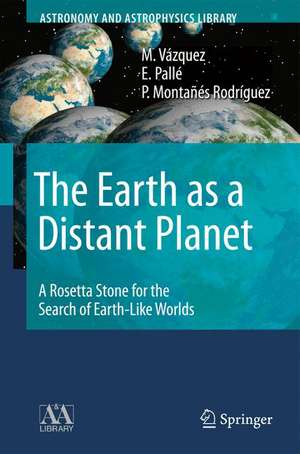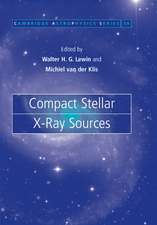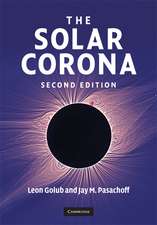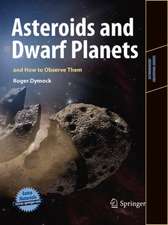The Earth as a Distant Planet: A Rosetta Stone for the Search of Earth-Like Worlds: Astronomy and Astrophysics Library
Autor M. Vázquez, E. Pallé, P. Montañés Rodríguezen Limba Engleză Hardback – 2 apr 2010
Since the discovery in 1992 of the first exoplanet, the number of planet detections has increased exponentially and ambitious missions are already being planned for the future. The exploration of Earth and the rest of the rocky planets are Rosetta stones in classifying and understanding the multiplicity of planetary systems that exist in our galaxy. In time, statistics on the formation and evolution of exoplanets will be available and will provide vital information for solving some of the unanswered questions about the formation, as well as evolution of our own world and solar system. Special attention is paid to the biosignatures (signs of life) detectable in the Earth's reflected spectra and the search for life in the universe.
The authors are experts on the subject of extrasolar planets. They provide an introductory but also very much up-to-date text, making this book suitable for researchers and for advanced students in astronomy and astrophysics.
| Toate formatele și edițiile | Preț | Express |
|---|---|---|
| Paperback (1) | 647.40 lei 6-8 săpt. | |
| Springer – 23 aug 2016 | 647.40 lei 6-8 săpt. | |
| Hardback (1) | 656.43 lei 6-8 săpt. | |
| Springer – 2 apr 2010 | 656.43 lei 6-8 săpt. |
Din seria Astronomy and Astrophysics Library
- 17%
 Preț: 496.38 lei
Preț: 496.38 lei - 15%
 Preț: 603.58 lei
Preț: 603.58 lei - 19%
 Preț: 455.25 lei
Preț: 455.25 lei - 17%
 Preț: 525.74 lei
Preț: 525.74 lei - 13%
 Preț: 393.37 lei
Preț: 393.37 lei - 19%
 Preț: 524.15 lei
Preț: 524.15 lei - 17%
 Preț: 393.90 lei
Preț: 393.90 lei - 15%
 Preț: 647.40 lei
Preț: 647.40 lei - 15%
 Preț: 541.54 lei
Preț: 541.54 lei - 17%
 Preț: 362.71 lei
Preț: 362.71 lei - 18%
 Preț: 1006.55 lei
Preț: 1006.55 lei - 18%
 Preț: 745.33 lei
Preț: 745.33 lei - 15%
 Preț: 641.20 lei
Preț: 641.20 lei -
 Preț: 397.38 lei
Preț: 397.38 lei - 15%
 Preț: 598.21 lei
Preț: 598.21 lei - 15%
 Preț: 658.05 lei
Preț: 658.05 lei - 23%
 Preț: 815.09 lei
Preț: 815.09 lei -
 Preț: 409.89 lei
Preț: 409.89 lei - 15%
 Preț: 610.61 lei
Preț: 610.61 lei -
 Preț: 393.90 lei
Preț: 393.90 lei - 15%
 Preț: 655.27 lei
Preț: 655.27 lei - 18%
 Preț: 951.47 lei
Preț: 951.47 lei - 18%
 Preț: 960.42 lei
Preț: 960.42 lei - 18%
 Preț: 1397.68 lei
Preț: 1397.68 lei - 18%
 Preț: 959.98 lei
Preț: 959.98 lei - 18%
 Preț: 1012.08 lei
Preț: 1012.08 lei - 15%
 Preț: 481.03 lei
Preț: 481.03 lei - 15%
 Preț: 672.43 lei
Preț: 672.43 lei -
 Preț: 413.15 lei
Preț: 413.15 lei - 18%
 Preț: 1554.72 lei
Preț: 1554.72 lei - 18%
 Preț: 1410.63 lei
Preț: 1410.63 lei -
 Preț: 390.08 lei
Preț: 390.08 lei - 18%
 Preț: 944.99 lei
Preț: 944.99 lei - 19%
 Preț: 502.94 lei
Preț: 502.94 lei - 15%
 Preț: 654.12 lei
Preț: 654.12 lei - 24%
 Preț: 851.64 lei
Preț: 851.64 lei - 19%
 Preț: 515.34 lei
Preț: 515.34 lei - 15%
 Preț: 663.14 lei
Preț: 663.14 lei - 18%
 Preț: 741.68 lei
Preț: 741.68 lei - 15%
 Preț: 647.40 lei
Preț: 647.40 lei -
 Preț: 388.90 lei
Preț: 388.90 lei - 18%
 Preț: 1217.72 lei
Preț: 1217.72 lei - 15%
 Preț: 651.51 lei
Preț: 651.51 lei - 15%
 Preț: 655.27 lei
Preț: 655.27 lei -
 Preț: 347.60 lei
Preț: 347.60 lei - 18%
 Preț: 794.39 lei
Preț: 794.39 lei
Preț: 656.43 lei
Preț vechi: 772.26 lei
-15% Nou
Puncte Express: 985
Preț estimativ în valută:
125.60€ • 131.15$ • 103.72£
125.60€ • 131.15$ • 103.72£
Carte tipărită la comandă
Livrare economică 15-29 aprilie
Preluare comenzi: 021 569.72.76
Specificații
ISBN-13: 9781441916839
ISBN-10: 1441916830
Pagini: 482
Ilustrații: XV, 422 p.
Dimensiuni: 155 x 235 x 25 mm
Greutate: 0.86 kg
Ediția:2010
Editura: Springer
Colecția Springer
Seria Astronomy and Astrophysics Library
Locul publicării:New York, NY, United States
ISBN-10: 1441916830
Pagini: 482
Ilustrații: XV, 422 p.
Dimensiuni: 155 x 235 x 25 mm
Greutate: 0.86 kg
Ediția:2010
Editura: Springer
Colecția Springer
Seria Astronomy and Astrophysics Library
Locul publicării:New York, NY, United States
Public țintă
ResearchCuprins
Observing the Earth.- The Earth in Time.- The Pale Blue Dot.- The Outer Layers of the Earth.- Biosignatures and the Search for Life on Earth.- Detecting Extrasolar Earth-like Planets.- The Worlds Out There.- Extrasolar Planetary Systems.- Is Our Environment Special?.
Recenzii
From the reviews:
“This very up-to-date book stresses the importance that future studies of the Earth will bring to our quest to discover life around extrasolar planets. … The book is also an excellent reference source for researchers interested in detailed summary descriptions of the Earth and its role in the search for extraterrestrial life and other planets. Includes striking color pictures, graphs, and figures; extensive end-of-chapter references; a list of acronyms and units; and a four-page index. Summing Up: Highly recommended. Upper-division undergraduates through professionals; general audiences.” (W. E. Howard III, Choice, Vol. 48 (3), November, 2010)
“This very up-to-date book stresses the importance that future studies of the Earth will bring to our quest to discover life around extrasolar planets. … The book is also an excellent reference source for researchers interested in detailed summary descriptions of the Earth and its role in the search for extraterrestrial life and other planets. Includes striking color pictures, graphs, and figures; extensive end-of-chapter references; a list of acronyms and units; and a four-page index. Summing Up: Highly recommended. Upper-division undergraduates through professionals; general audiences.” (W. E. Howard III, Choice, Vol. 48 (3), November, 2010)
Notă biografică
The authors are researchers at the Instituto de Astrofísica de Canarias. M. Vázquez is also author of Ultraviolet Radiation in the Solar System and The Sun Recorded Through History.
Textul de pe ultima copertă
Is the Earth, in some way, special? Or is our planet but one of the millions of other inhabited planets within our galaxy? This is an exciting time to be asking this old question, because for the first time in history, the answer is within reach. In The Earth as a Distant Planet, the authors set themselves as external observers of our Solar System from an astronomical distance.
From that perspective, the authors describe how the Earth, the third planet in distance to the central star, can be catalogued as having its own unique features and as capable of sustaining life. The knowledge gained from this original perspective is then applied to the ongoing search for planets outside the solar system, or exoplanets.
Since the discovery in 1992 of the first exoplanet, the number of known planets has increased exponentially. Ambitious space missions are already being designed for the characterization of their atmospheres and to explore the possibility that they host life. The exploration of Earth and the rest of the rocky planets in our Solar System will help us in classifying and understanding the multiplicity of planetary systems that exist in our galaxy. In time, statistics on the formation and evolution of exoplanets will be available and will provide vital information for solving some of the unanswered questions about the formation, as well as the evolution, of our own world.
The authors provide an introductory but also very much up-to-date referenced text, making this book useful not only for the layman, but also for researchers and advanced students in Astrophysics and Earth Sciences.
From that perspective, the authors describe how the Earth, the third planet in distance to the central star, can be catalogued as having its own unique features and as capable of sustaining life. The knowledge gained from this original perspective is then applied to the ongoing search for planets outside the solar system, or exoplanets.
Since the discovery in 1992 of the first exoplanet, the number of known planets has increased exponentially. Ambitious space missions are already being designed for the characterization of their atmospheres and to explore the possibility that they host life. The exploration of Earth and the rest of the rocky planets in our Solar System will help us in classifying and understanding the multiplicity of planetary systems that exist in our galaxy. In time, statistics on the formation and evolution of exoplanets will be available and will provide vital information for solving some of the unanswered questions about the formation, as well as the evolution, of our own world.
The authors provide an introductory but also very much up-to-date referenced text, making this book useful not only for the layman, but also for researchers and advanced students in Astrophysics and Earth Sciences.
Caracteristici
Provides a guide for the remote detection of life on other planets Presents an updated perspective of our planet as seen from outer space Establishes the Earth-Exoplanets connection and its value for a better understanding of our own planet as well as other planets beyond the solar system Includes supplementary material: sn.pub/extras














